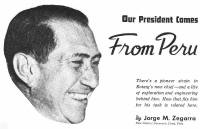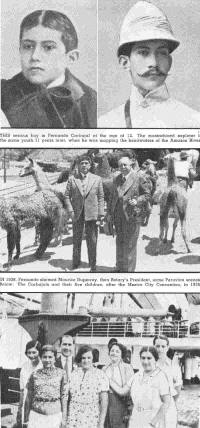|

IN PERU we often speak
of Fernando Carbajal as "the Peruvian Paul Harris." And Rotarians of
Lima refer to him as "our Ches Perry."
There is really a good
reason for each of these titles. It was Fernando who brought Rotary to
the West coast of South America, for in 1921 he organized the Rotary
Club of Lima. It was Fernando who self ‑sacrificingly served 14 years as
Secretary of that Club, until he bowed to popular demand and accepted
the Presidency.
Most of you know what
followed for Fernando‑his District Governorship, his First
Vice‑Presidency of Rotary International, his service on many Committees,
and now our international Presidency.
Pioneering in Rotary
came naturally to Fernando Carbajal, for he has always been a pioneer.
It is in his blood. His family came to Lima when the pioneers came. One
of his forebears was Manuel Ascensio Segura, who was a pioneer in poetry
and in drama, and who left a deep imprint on Peruvian literature.
Furthermore, don Manuel was also a pioneer in the political arena, being
an early member of the Cortes, or Congress, and in the newspaper field,
for he was the founder of El Comercio, oldest and largest of
Peru's daily papers.
Fernando started his
pioneering early. He was only 20 years old when he was graduated from
the Peruvian School of Engineering and Mining, and he plunged at once
into tropical jungle exploration. Along Peru's Eastern borders, down the
slopes of the great Andes that are the backbone of the country, flow
great rivers that unite to make the Amazon. In 1900, when Fernando
finished college, these were terra incognita to most Peruvians.
Into this unknown land he led a party which mapped the courses of the
Inambari, the Madre de Dios, and the Aguaytia Rivers.
In 1905 the United
States was building the Panama Canal, and important pioneering was being
done in the field of sanitation and health control. Fernando Carbajal
went to the Canal Zone, and for two years worked there, filling several
positions, mainly in the field of municipal sanitation. Following this,
the Peruvian Government, in 1907, sent him to the United ‑States and
Cuba to study the newest improvements in sanitation in those countries.
On his return to Peru
he was given control of sanitation works in the Chanchamayo Valley.
Somehow or other he found time to visit Lima, and in 1908 he married
Senorita Carmela Balbuena, a member of another old family of that
capital. In 1909 he returned to Lima as State engineer of Peru in charge
of public works.
Peru has a long
coastline and many harbors. The docks of these ports are under the care
of the department of public works, and it was with their construction,
maintenance, and repair that Fernando was charged for 11 years. However,
during one of those years, from 1912 to 1913, his early explorations
made him the logical choice as head of the commission that settled the
Peruvian‑Bolivian border claims along the very rivers he had explored.
During this period
occurred an incident which had a deep influence on his career. Two
railroad companies had rival claims, and, as State engineer, it was
Fernando's task to decide the issue. One of the companies was closely
linked with the Government, the other was not. Yet the decision was made
in favor of the company with no governmental connection.
Fernando forgot the
incident. He simply did his duty as he saw it. But years later, when the
telephone company was looking for a general manager, one of the
directors who had been a director of the railroad company, remembered.
He did not know Fernando personally, but he did know honesty and
ability, and Fernando was selected for the post. He is now
vice‑president as well as general manager of the telephone enterprise,
and it has been his work since 1920. |
Although the telephone
company is his main task, he has also found time to serve as a director
of the Industrial Bank of Lima and as vice‑president of the Crandall
Engineering Company of Boston, Massachusetts.
Rotarians who were at
the international Convention at Mexico City in 1935 will remember
Fernando's family, for Senora de Carbajal and all five of their children
were with him. There are one son, Fernando, Jr., and four daughters‑Carmela,
Berta, Luisa, and GracieIa. The three eldest are married, and Fernando
has three grandchildren to enjoy.
We who have been his
fellow members in the Rotary Club of Lima were not entirely surprised
when we learned of his unanimous selection by the Nominating Committee
of Rotary International. Hadn't we elected him President of our Club the
same way? Don't we know his worth? We did not learn of his selection
from him, however, but from Julio Gerlein Comelin, Director of Rotary
International, who stopped to visit us between planes on his way to
Chile. It was Fernando's birthday, and we were all guests of Past
District Governor Andres F. Dasso and his charming wife when Julio told
us of the action of the Committee.
Fernando tried to
assure us that our congratulations were premature, that there were
others who might be nominated. But after April 1, when Tom J , Davis,
President of Rotary International, declared him to be the "President
Nominee," he could no longer deny us the pleasure of congratulating him.
I have known and
cherished the friendship of Fernando Carbajal a long time, and I do not
feel that I am breaking, but rather that I am sharing, a confidence when
I repeat what he told me when the news became known.
"I hesitated a long
time, despite the urgency of the moment, to answer the Nominating
Committee," he said. "I appreciate the honor, and I know the
difficulties that surround the post today. But it was put to me as an
opportunity to serve!"
"An opportunity to
serve" is a call to action for our President. When he was Governor of
our District in 1935‑36, he learned that by taking an arduous and
somewhat dangerous flight over the Andes, he could visit the outlying
Rotary Club of Iquitos, which had never been visited. Of course he went!
We in Lima know of
Fernando's long and varied experience in commercial and professional
life, and in Rotary. We feel honored in his choice for the Presidency of
Rotary International, and know that he will do honor to the position. We
feel that all Rotary in Peru, which counts him as its most shining
example, shares the opportunity of service with him.
Those of us who know
him well‑and there are many Rotarians all over the world who can say
that‑know what force of mind and of character, what stores of placid
energy, and what an unusual reserve of executive ability he brings to
his new position.
Therefore, we say to
you, in all sincerity and complete confidence, that this year, once
more, Rotary International has placed its Presidency in the hands of a
man who can do the job and has put the right man in the right place!

From an article in the
July 1942 issue of The Rotarian by Jorge M. Zegarro, PDG, Lima, Peru
Prepared by
Wolfgang Ziegler
7 September 2003 |

